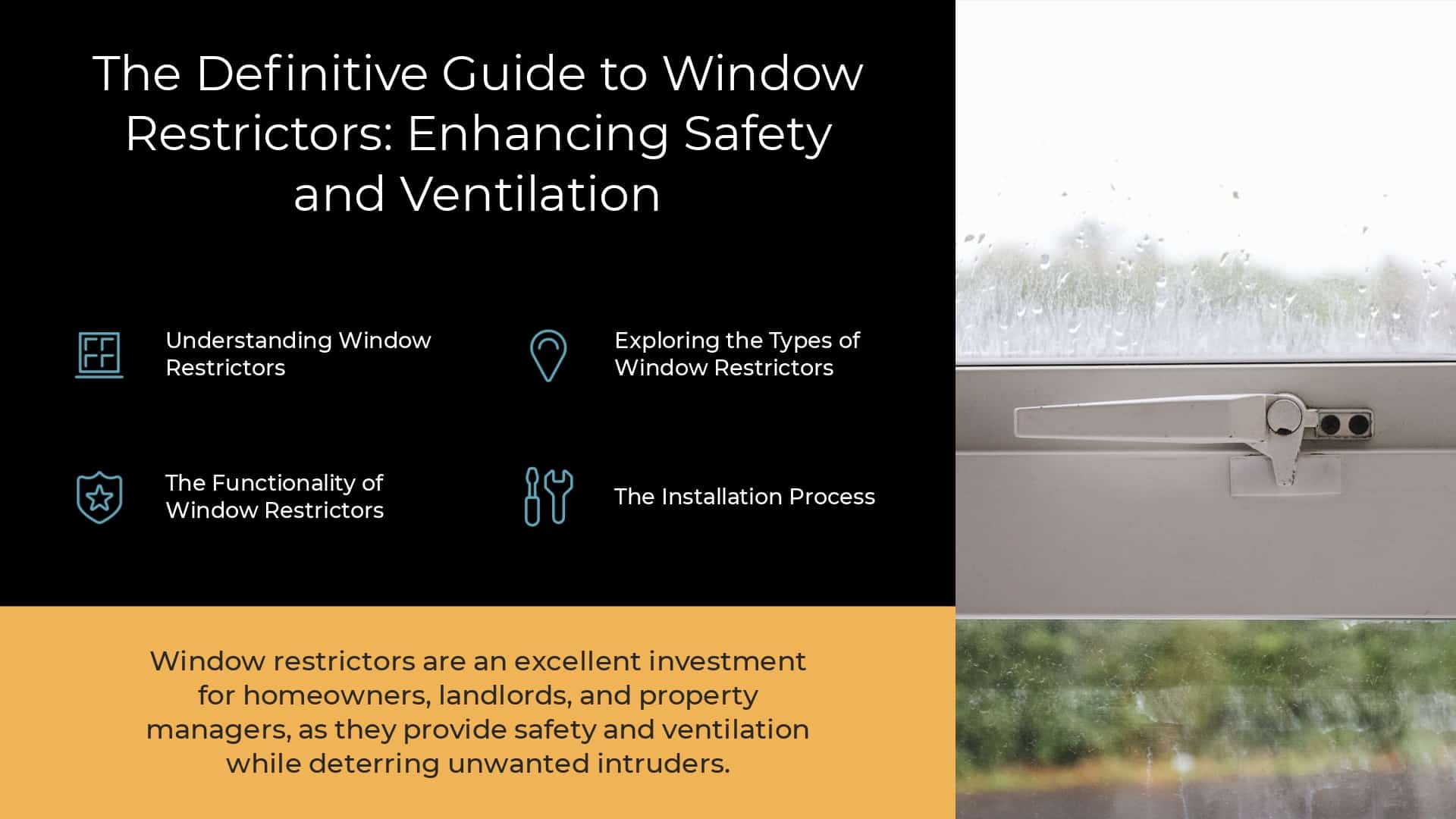Last Updated on May 15, 2023 by Pro Handyman Editorial Team
The Definitive Guide to Window Restrictors: Enhancing Safety and Ventilation
Window restrictors are integral to maintaining a safe and well-ventilated environment within your home. Catering to the safety needs of all, especially children and older people, these devices are an excellent investment. This comprehensive guide will delve into the intricacies of window restrictors, offering a complete understanding of their benefits, types, and procedures for their installation.
Understanding Window Restrictors
Window restrictors are safety devices that limit the opening capacity of your windows. While they come in various styles, all ensure ample ventilation and occupant safety. In addition, they are simple to install and offer homeowners, landlords, and property managers peace of mind.
The Functionality of Window Restrictors
Window restrictors serve two primary purposes. Firstly, they ensure child safety by creating smaller window openings, reducing the risk of accidents. Additionally, they deter unwanted intruders, although this is not their primary function and a small window opening could be exploited.
Exploring the Types of Window Restrictors
Window restrictors come in various styles suitable for different types of windows. Here, we will explore some of the most common types available on the market.

Concealed Window Restrictors
Fitted inside the window frame, these restrictors feature a metal piece that can be released to open the window entirely. So though they don’t require a key, it’s possible to open the window accidentally.
Retrofitted Window Restrictors
These feature a steel or cable part and can be locked or unlocked using a key. While they enhance security, keeping track of the key can be challenging.
Sash Window Restrictors
Sash window restrictors limit the opening of the sash, the part that holds the glass in place in operable windows. They function as locks and are unlocked with a key for unrestricted access. Limiting the sash openings to 100 mm is advisable for optimal safety and ventilation.
Restrictor Cables
These devices use a small window cable to minimize window openings. But unfortunately, they can’t be used to lock windows in a fully closed position and require custom installation on metal or aluminum frames. So while they’re excellent for child safety, their efficacy for home security is limited.
Snap Lock
Designed for PVC window frames, Snap Locks don’t require a key. Instead, the arm attached to the exterior window connects to the block on the interior window frame and is unlocked using a two-finger release.

Sliding Lock
Built for sliding windows, these work more as stoppers than locks. As a result, they’re effective for child safety but need to be more sufficient for security purposes.
Lock Pins
Used on sliding windows, these affordable restrictors can be homemade by drilling a hole through the window frame and window, then inserting a pin.
Folding Latches
Ideal for awning windows, these devices include a handle on the base frame that latches when the window is closed.
Restrictor Stays
These devices attach to the window and frame; once installed, the window cannot open wider than intended.
Trickle Vents
While not window restrictors, these devices allow for minimal ventilation without opening the window and are built to withstand the elements and prevent outdoor debris from entering the home.
The Installation Process
Window restrictors installation will vary depending on the type. Many can be installed using a handheld electric drill, while others may require custom installation. Always check the specifications for each restrictor before starting the installation.

Safety Considerations
Window restrictors contribute significantly to occupant safety. Here are a few points to consider:
- Do not install on windows designated as fire escapes.
- Ensure all adults understand the proper use
- Store the keys for lock restrictors in a safe and easily accessible place.
- Limit window openings to 100 mm for optimal child safety.
- Consider installing restrictors on all windows above the ground floor.
Practical Considerations
- Window restrictors must be correctly installed and used to be effective.
- Not all restrictors provide sufficient outdoor security.
- An open window, regardless of restrictions, is an insecure window.
- Some windows may require more than one restrictor for optimal safety.
The Imperative Role of Window Restrictors
As stewards of care homes and facilities, our paramount concern is the safety and well-being of residents under our care. One critical aspect of this responsibility is the need to understand, select, and deploy the most reliable window restrictors to ensure a safe environment.
Selecting the Robust Window Restrictor: A Critical Decision
Selecting the right window restrictor is a crucial decision, given the many options available in the market. The ideal window restrictor must balance maintaining safety standards and providing comfort for the residents. In addition, it should prevent accidental falls, ensure security against potential intrusions, and simultaneously allow for ventilation.
Understanding Window Restrictor Strength
The Department of Health and CQC regulations recommend window restrictors capable of withstanding a force of 500 newtons, equivalent to around 112 lbs or eight stone. This level of resistance provides safety against accidental leaning or forced intrusion attempts.
However, it is crucial to recognize that care facilities house residents with various risk profiles, including those with a confused mental state or at risk of deliberate self-harm. Therefore, each individual’s risk must be assessed, and the strength of the window restrictor adjusted accordingly.
For instance, the Jackloc cable window restrictors have proven their merit by being independently tested to hold over four times the British Standards state on steel, aluminum, and timber window frames. The Titan by Jackloc folding restrictor, in particular, exhibits remarkable strength, capable of holding up to 74 stones, equivalent to five adult males.

Quality Matters in Window Restrictors
The quality of a window restrictor can dramatically impact its performance. While cutting corners on costs is tempting, investing in quality restrictors made from reliable parts ensures superior strength and durability.
The Jackloc window restrictors, manufactured entirely in the UK, assure customers of their quality through rigorous and regular product tests. Each Jackloc is strength tested during manufacturing and put through several manual and machine performance tests. Any failure at any stage leads to immediate removal from the process.
The Security Aspect of Window Restrictors
Ground-floor residents of care homes and those living alone are particularly vulnerable to intrusions. Window restrictors, such as the Jackloc cable restrictor, offer an additional layer of security. However, with a cable thickness of over 3mm and reinforced strength due to multiple inner weaving, it would require bolt cutters to break it.
Moreover, the patented five-disc locking barrel mechanism and the security grade 4 anti-tamper screws add another layer of protection. These features ensure that the restrictor cannot be tampered with unless using a specific drill part, providing residents with peace of mind even with open windows.
In Conclusion
Ensuring a safe and secure environment for elderly or vulnerable residents is a non-negotiable aspect of running a care facility. Constant assessment of home requirements and a discerning eye for differentiating between products is critical. For example, when considering window safety, knowing what’s in your window restrictor and why you made that choice is essential.
With the right window restrictors Installation, care facilities can provide a safe environment for residents, providing them with peace of mind and a sense of security.
